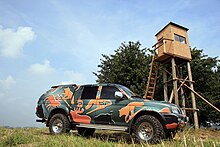Full vehicle wrapping


The term vehicle wrapping , also English. Car wrapping is the term used to describe the large-area application of self-adhesive, highly elastic and stretchable plastic film to the outer skin of vehicles. This can be done for design, labeling or advertising purposes. A widespread area of application is full advertising on public transport. It is also used to mark vehicles used by the rescue service or the police . In the private sector, full vehicle wrapping is used for vehicle tuning . Car manufacturers try to keep the appearance of their prototypes secret with the so-called Erlkönig with a special pattern.
properties
The shelf life for the film is specified as seven years or more, depending on the manufacturer. Printed materials have a shorter lifespan than products that are colored through, as the inks used react strongly to UV radiation and fade. For this reason, these large format prints are laminated using either suitable liquid or foil laminates. Foil laminates are preferred for car wrapping: they are more elastic, more stretchable and offer greater protection against mechanical stress.
Foiling process
The process of wrapping is divided into different work steps: preliminary work, cleaning, wrapping, final and follow-up inspection.
The preliminary work includes measuring each body part individually and cutting the film parts accordingly. The outer shell is cleaned at the same time or afterwards. Coarse dirt deposits from everyday use are removed and then the surfaces and edges are degreased with a special cleaner. This ensures the perfect adhesive strength of the film. The foiling process itself can only begin once this work has been completed. Individual body parts are glued in one piece. The film is made stretchable at curves such as beads and rivets with hot air and thus adapted to the shape of the vehicle part. If done incorrectly, the film can later loosen and tear at these points. After the vehicle part is finished with foiling, a new original point of the foil can be achieved by heating the foil edges to 90 ° C to 100 ° C. This loses its retreat properties. After a few weeks, a follow-up check should be carried out by the foiler. The movements of the material can cause edges or corners to loosen and need to be corrected.
Advantages and disadvantages
Compared to painting, full vehicle wrapping is cheaper and can be quickly reversed by peeling off the film. The film protects the original paint from UV radiation, small scratches and stone chips .
With "visual wrapping", only externally visible vehicle parts are wrapped. Areas such as the inside of the tank lid or entry areas inside the door frame are not covered with stickers. If the workmanship is poor, the original color of the vehicle can also be seen from the outside on the edge of the body parts.
Complete wrapping also includes the door entrances, insides of doors and tailgate. This sometimes requires dismantling the doors and panels in the interior in order to enable seamless foiling.

